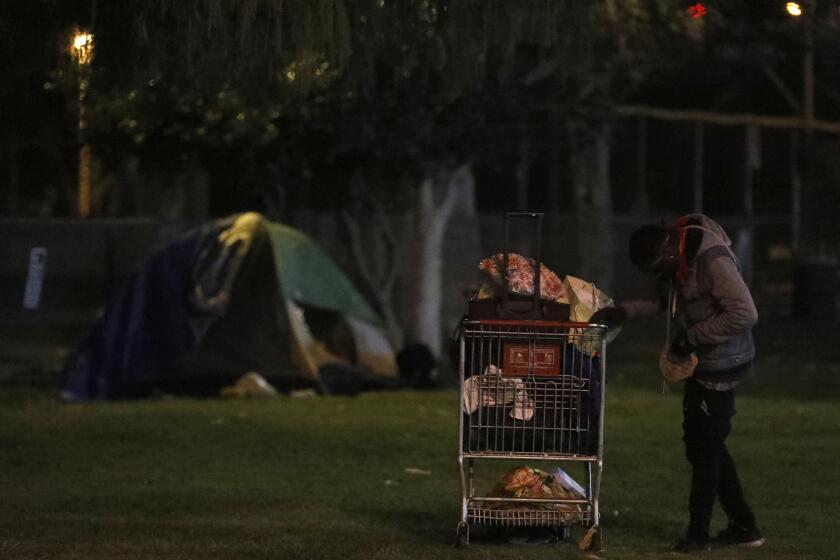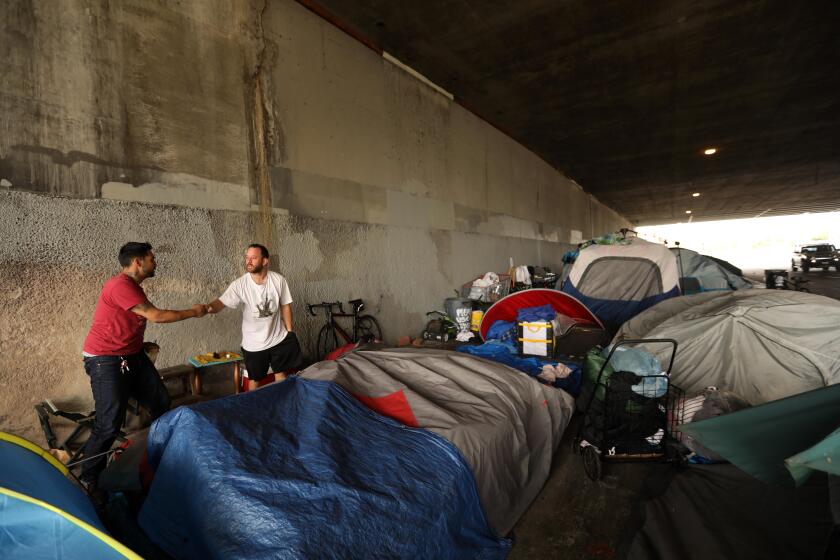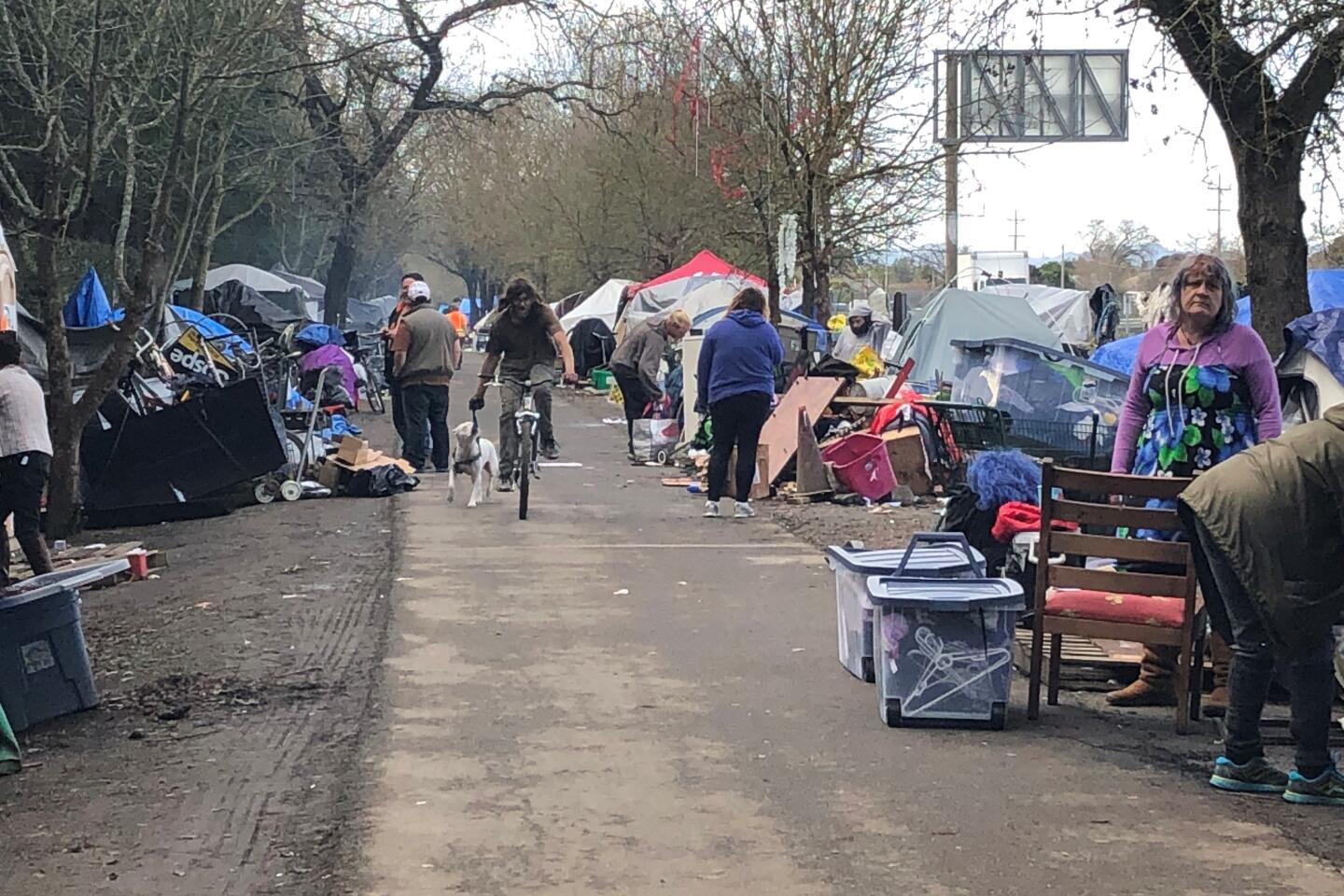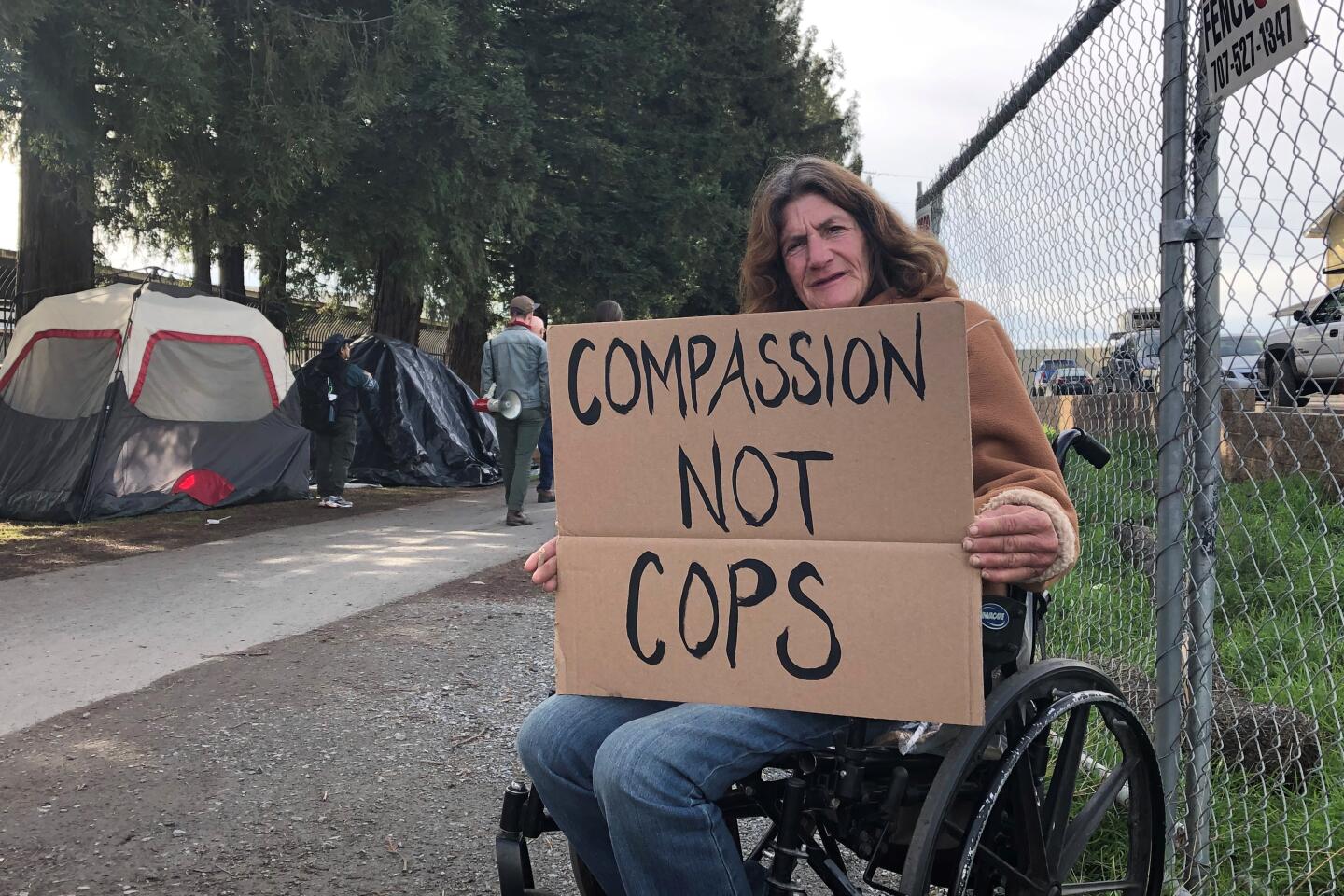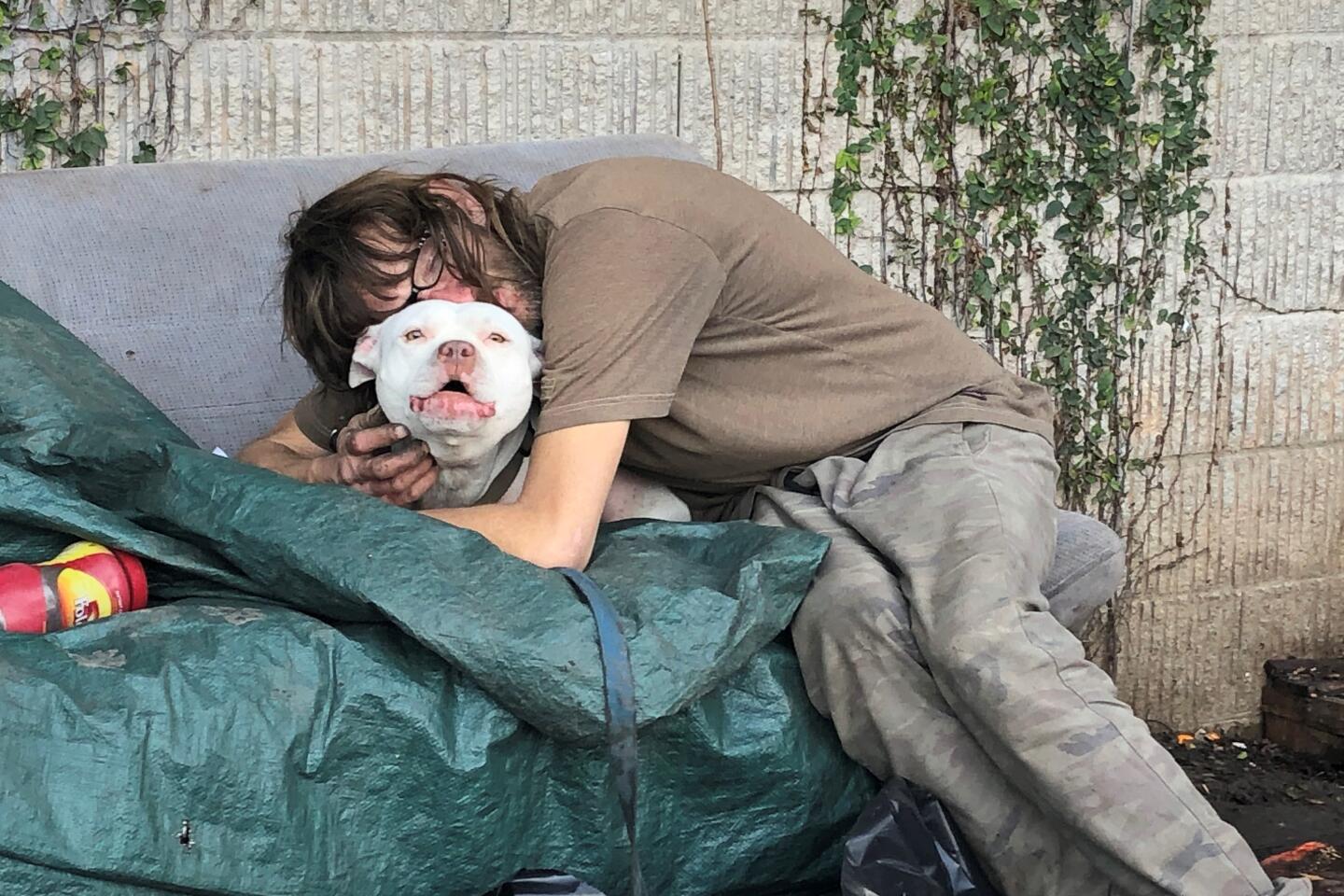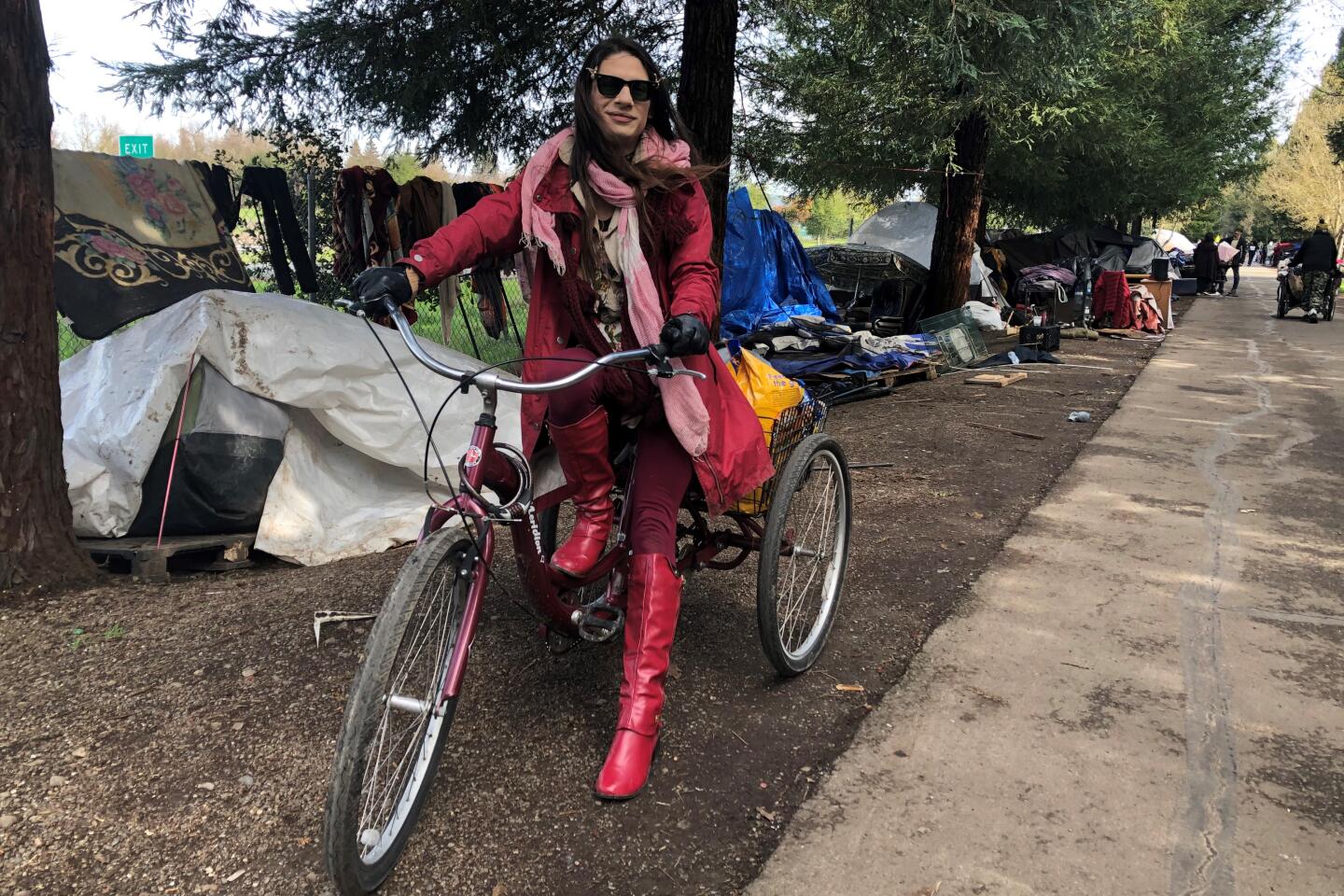Trump wants California cops to evict homeless people. They don’t want that ‘dirty’ job
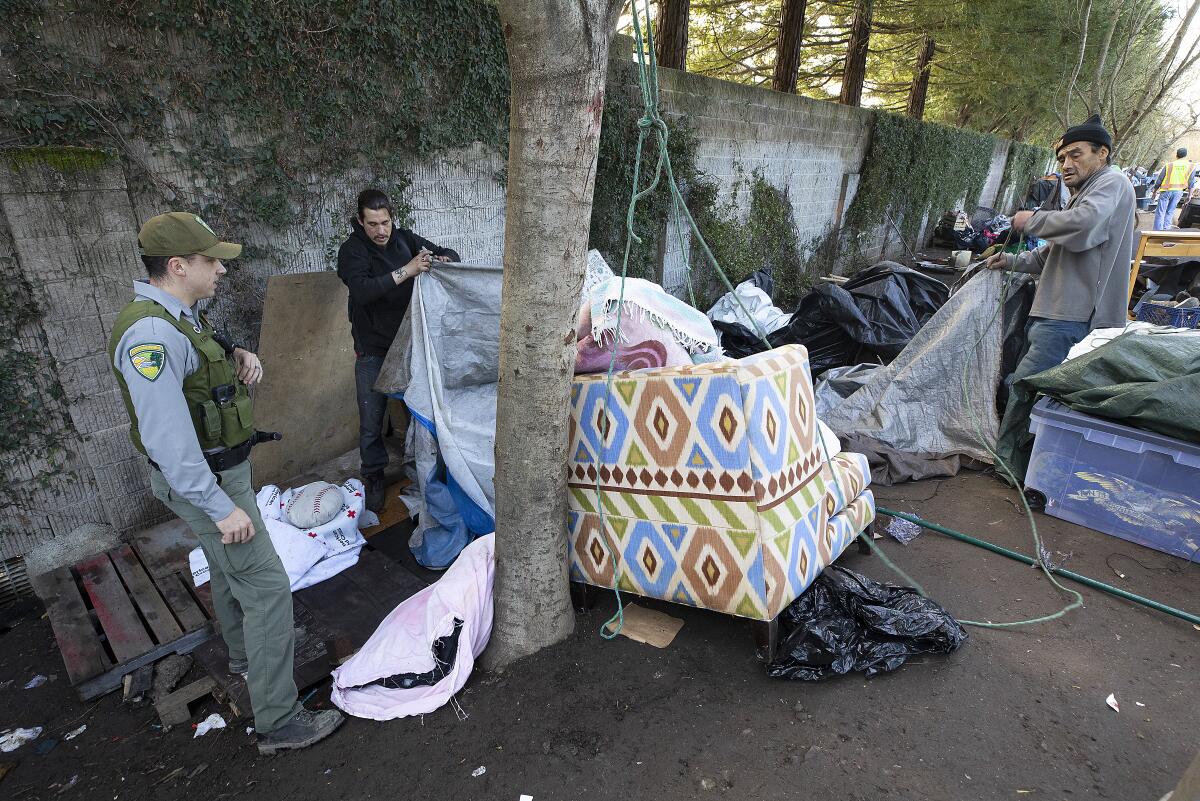
- Share via
SANTA ROSA — No one looked happy to be on the Joe Rodota Trail in Sonoma County earlier this month — not the homeless people who had built a miles-long encampment, not the park rangers tasked with making sure they left and not the police officers sent as backup.
Last summer, more than 250 people with no place else to go — veterans, elderly women and men, teenagers, parolees and addicts — started building this shantytown, complete with its own economy, including a bike parts salesman and a “credit card lady.” Residents said there was a sense of community, safety and comfort there. Though plagued by violence, thievery and a heroin-fentanyl mix called red rock, there were rules in what they called “Camp Rebel: No Longer Sorry.”
But the families and commuters who used to walk and bike under the oaks and redwoods on the trail were gone, warned away by fears of crime and rats rumored to be the size of cats. And so the Sonoma County Board of Supervisors ordered the camp closed by the end of January.
The question became who would force the homeless people to leave. City police, county sheriff’s deputies or another agency? Arriving at an answer proved to be contentious, but offered a rare peek at the growing dismay within law enforcement agencies as California’s homelessness crisis continues to intensify and the public’s patience with it grows increasingly thin.
Political leaders at the local, state and federal levels are calling for actions that could directly or indirectly expand the responsibilities of cops in managing the tens of thousands of homeless people who live outdoors. But many rank-and-file officers are tired of being asked to be both social workers and enforcers, and top brass are equally critical of such suggestions, arguing that they aren’t equipped to be the front line of this crisis.
The Times is launching a new section on latimes.com to bring together our best coverage to date on both homelessness and housing.
“Most police officers don’t necessarily want to deal with homelessness, and I’m not sure it’s a policing issue,” said Ron Lawrence, president of the California Police Chiefs Assn. “Homelessness in and of itself is not a crime, and people need to understand that sometimes policing is not the best intervention.”
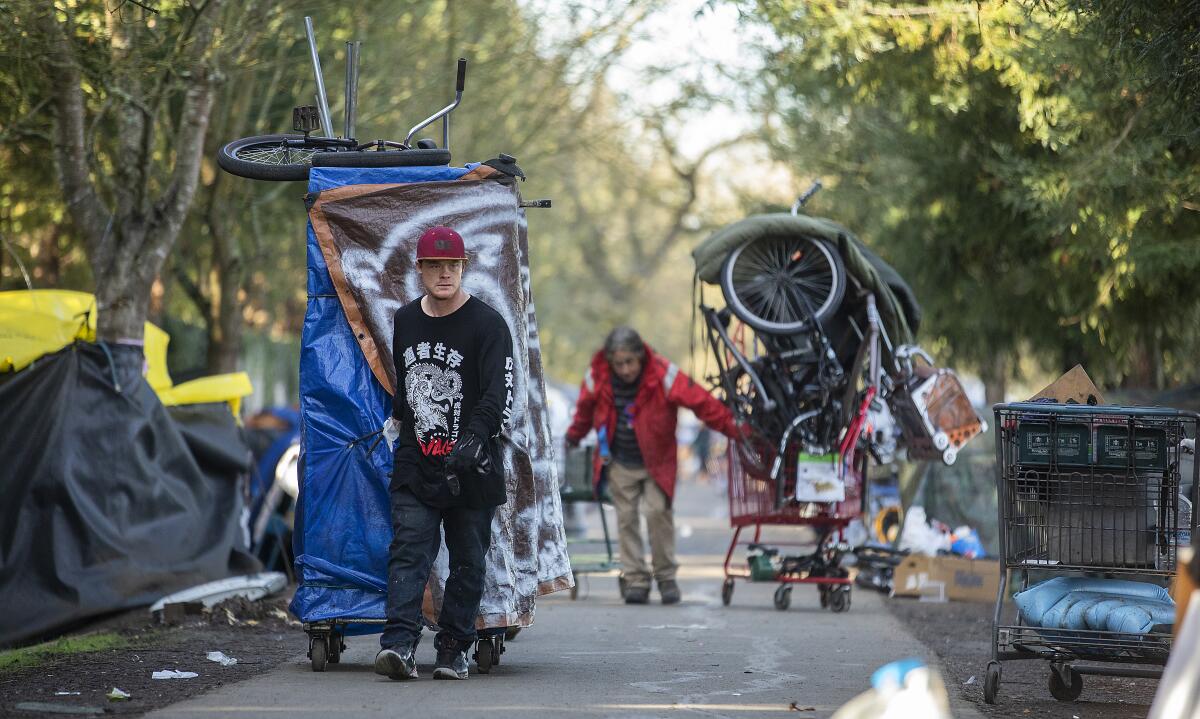
In recent months, U.S. Housing and Urban Development Secretary Ben Carson, echoing rhetoric from President Trump about a possible crackdown on homeless encampments in California cities, called for “empowering and utilizing local law enforcement,” in a letter to Los Angeles Mayor Eric Garcetti. In a Fox television interview, Carson also said state officials needed to “uncuff law enforcement so that people can be removed now and placed in transitional places.”
Although public opinion of the Trump administration remains low in California, so is opinion of allowing the status quo to continue on homelessness. A recent Times poll found that a large majority of L.A. County voters believe police should be more active in addressing homelessness.
Before a recent series of court decisions and legal settlements spelling out rights for homeless people, cops had been far more involved because the issue was often largely handled through crackdowns on petty crimes such as public urination or littering. As recently as the mid-2000s, law enforcement used citations and arrests to break up encampments and seize homeless people’s property.
But a ruling in the case Martin vs. City of Boise in 2018 marked a significant victory for homeless advocates after more than a decade of civil rights lawsuits. Law enforcement agencies across California and several other Western states suddenly had to adhere to new rules on when and how encampments could be cleared, adding a de facto layer of social work for any officer dealing with unsheltered people.
Get informed on the latest news and statistics on housing and homelessness in L.A., California, and throughout the U.S.
Coupled with a lack of housing options, the rules also slowed down enforcement, contributing to the perception that police cannot or will not address the health and safety problems often posed by encampments.
That is one reason several cities and counties, including Sacramento, supported a challenge to Martin vs. City of Boise, the federal appeals court ruling that prohibits punishing homeless people for sleeping on public property when no shelter beds or housing are available. The U.S. Supreme Court declined to hear the case, however, leaving the lower court ruling intact and cities and counties to deal with the realities of their multiplying encampments.
At the state Capitol, legislators have reframed the discussion on homelessness to be about the inhumanity of continuing to leave people to die on the streets. Gov. Gavin Newsom has spoken about the need to revise the state’s law governing conservatorships, potentially expanding the number of people who can be forced into treatment. It’s an idea that, on the street level, could involve using law enforcement to help identify and detain homeless people to be conserved.
In San Francisco, a pilot program passed by the Legislature in 2018 will use the number of times police take a person in for a mental-health hold as a marker for who qualifies for involuntary treatment. Los Angeles and San Diego are authorized for similar programs, but are not as far along.
“There is a lot of frustration in my profession,” said Brian Marvel, president of the Police Officers Research Assn. of California, which lobbies for law enforcement interests. “I personally don’t think this is the right direction to go.”
Being both a cop and a social worker can be rewarding, but poses a risk both for officers and homeless people and has fundamentally changed the job of law enforcement. Marvel said having to be the first person to approach someone in a mental health or addiction crisis, which is common when dealing with homeless people, is especially difficult at a time when the use of police force is under scrutiny.
Help us inform our reporting about the homelessness crisis in California by submitting your questions.
“Strictly having police officers deal with this issue is a recipe for disaster,” he said. “This needs to be discussed from a team perspective and not dumped in the lap of law enforcement.”
Robert Harris, director of the union that represents Los Angeles police, said his rank-and-file members “don’t want to be obstructionists,” but often feel left out of policy discussions that directly affect them. “We are about trying to find real solutions to some of these tough issues, and we are hoping that law enforcement can stop being the easy way out for lawmakers,” he said.
In Santa Rosa, multiple officials said the city and county saw the Rodota Trail homeless encampment as a political and legal hot potato, and they didn’t want to be the ones in charge of “this dirty role of kicking people out,” as activist Marni Wroth, 70, put it last week, standing zip-tied to a gate to protest the police presence.
Along with drug use and people with untreated mental illness on the trail, there was activism and outrage — and a federal injunction specific to Sonoma County that is stricter than the Boise ruling. All were reasons to be skittish, and the stress of the situation was palpable as a weeks-long standoff came to its final days on the muddy edges of the pavement.
Santa Rosa “made a choice not to displace this because it was county land, and they were trying to get [the county], to get our sheriff to do it, and we said, ‘It’s your jurisdiction,’” said Sonoma County Supervisor James Gore. But while the city and county argued, the encampment grew, and “we had to go dive into it,” he said, even though the supervisors didn’t want to “criminalize” homelessness by involving the sheriff.
The Sonoma County Sheriff’s Department said it had no jurisdiction over the area. That left Sonoma County park rangers, who had never led an operation to clear a homeless encampment, as the lead law enforcement agency, with help from county mental health staff and emergency service workers.
The rangers slow-rolled the trail starting last Wednesday with a pickup truck and a dozen men, stopping at each structure to let residents know they had to leave by Friday or possibly face arrest.
They “understandably feel nervous,” said Sonoma County parks spokeswoman Meda Freeman. “Rangers, really their mission is to help people enjoy a park property, understand it, follow the basic rules,” Freeman said. “They’re not the people who usually book you and take you to jail. That’s not what they enjoy doing.”
Half a dozen Santa Rosa police officers accompanied the rangers. But Sgt. Jonathan Wolf, head of the city’s downtown enforcement team, which predominantly handles homeless issues, was quick to point out that they were present only for advice and emergencies.
“What I’d like people to know is we are not coordinating this,” Wolf said.
By Friday morning, about 50 campers remained scattered on the trail among the abandoned shelters, which, with pallet foundations, front porches and even a second story on one, had a ramshackle permanence. Much of what had been makeshift homes was now garbage: abandoned tents, torn mattresses, used needles ground into the dirt, a baby doll, a pile of yams, gas cans, a marine battery and several hundred tons of detritus that would have to be removed by a hazmat team.
About halfway through the encampment, authorities encountered Steve Floyd, 33, sitting on a gray futon balanced on milk crates, his blond hair pulled into a ponytail. Floyd, charismatic and intense, said he wanted to see how long he could push the rangers off. When they approached, he told them he didn’t want to leave on his own and that he thought an arrest might provide him with “a vacation.”
“It’s tough work out here,” he said.
Could Floyd be ready to leave by 4 p.m., “if I leave you with some totes and bags ... and no distractions?” the ranger asked. Floyd agreed, although he said he had lived at multiple homeless camps that had been cleared, and was tired of the whack-a-mole nature of the enforcement.
His resistance, he said, was “not for me. It’s not for the trail. It’s about being able to live and not be scared it will all be taken away.”
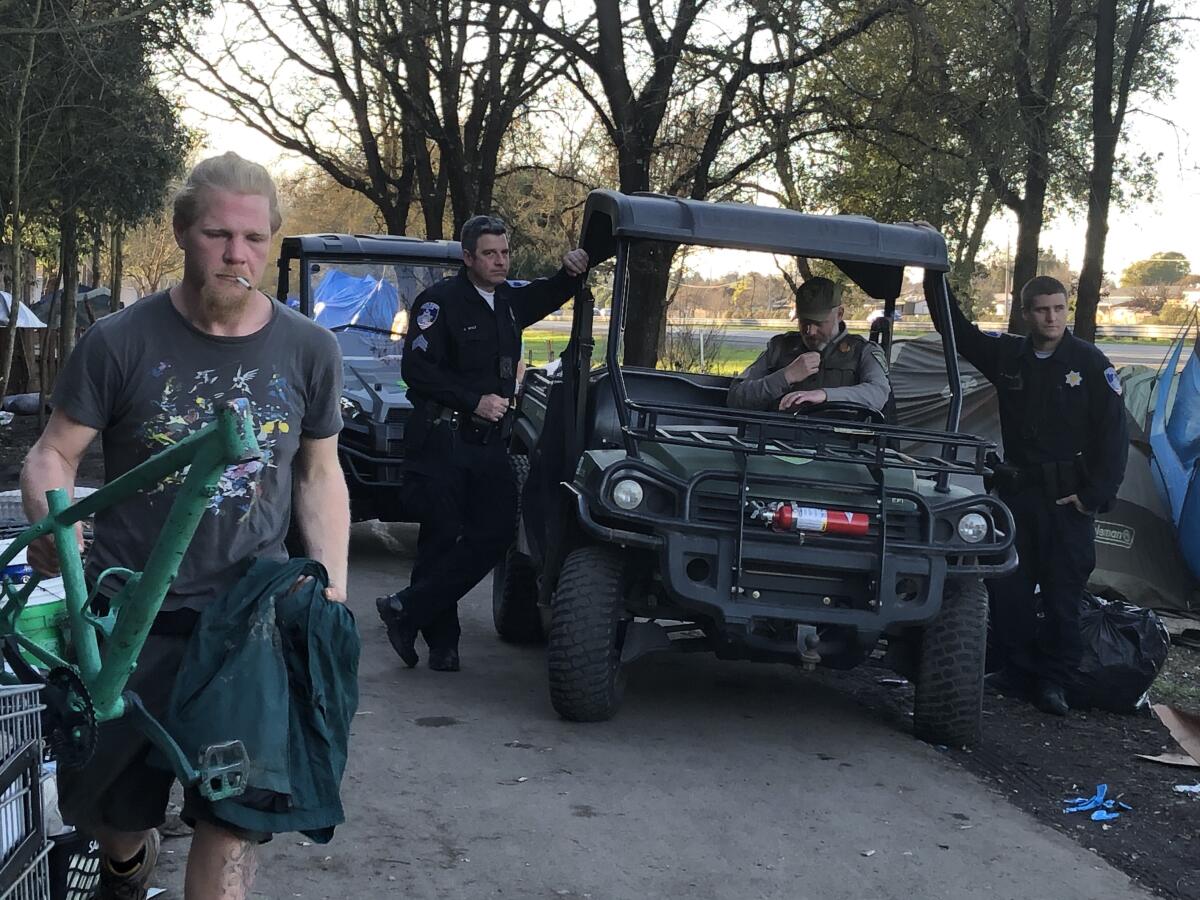
Officer Jeff Travers, part of Santa Rosa police’s homeless team, said the rangers were being more lenient than he would have been. He would have given Floyd a couple of hours, not half a day. Travers said he has come to believe that law enforcement is the most effective when it uses toughness as well as encouragement.
He recounted the story of a teenage heroin addict who had been living on the trail. He said she had been sexually exploited because of her addiction. Travers said his team arrested her multiple times, but in working with a group that included her public defender, convinced the teenager to go to rehab instead of jail. Now, Travers said she is living with her father and attending community college.
“Yes, some people definitely hate us,” Wolf said. “I would argue that, actually, that’s where more accountability can actually have more of an effect than a complete lack of consequences.”
Wolf said his job has become both frustrating and rewarding as Sonoma County’s homeless population has expanded. After the sweep last week, 60 people were given temporary housing in tiny homes, and more entered shelters. But others were simply displaced.
“Truthfully,” Wolf said of how he feels about his job, “it depends on what day you ask.”
By Friday afternoon, it was clear to authorities that Floyd would probably be their toughest holdout. At 2:30, Floyd used a piece of tinfoil and a metal tube to smoke heroin. The county-provided plastic bins sitting next to him were still empty. But when rangers reached their 4 p.m. deadline and they descended on Floyd’s site, he gave in, wheeling his possessions off the Joe Rodota Trail and into the parking lot of a Goodwill. He was once again in the territory of Santa Rosa police.
The entire trail had been cleared with no arrests, but Floyd and Wolf said the whole process would probably be repeated when another encampment pops up. Former residents were already scouting new sites, and by Tuesday, about 30 people had set up their belongings on a county road in the sheriff’s jurisdiction. Community activist Marcos Ramirez said 20 more were on their way.
“Ten years ago, it wasn’t like this,” said Wolf. “I’m not really glad it’s become part of what we do.”
More to Read
Sign up for Essential California
The most important California stories and recommendations in your inbox every morning.
You may occasionally receive promotional content from the Los Angeles Times.
